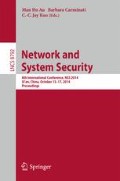Abstract
In the graded encoding systems that can be used to construct multilinear maps, the graded Computational Deffie-Hellman problem gGCDHP problem is assumed to be hard. We present an equivalent problem, called the variant graded Computational Deffie-Hellman problem vGCDHP, and make generalization to get the general graded Computational Deffie-Hellman problem gGCDHP. Based on the hardness assumption of gGCDHP, we construct the first ID-based threshold ring signature scheme from lattices. The scheme is proved in the random oracle model to be existentially unforgeable and signer anonymous.
Access this chapter
Tax calculation will be finalised at checkout
Purchases are for personal use only
Preview
Unable to display preview. Download preview PDF.
References
Bettaieb, S., Schrek, J.: Improved Lattice-Based Threshold Ring Signature Scheme. In: Gaborit, P. (ed.) PQCrypto 2013. LNCS, vol. 7932, pp. 34–51. Springer, Heidelberg (2013)
Bresson, E., Stern, J., Szydlo, M.: Threshold Ring Signatures and Applications to Ad-hoc Groups. In: Yung, M. (ed.) CRYPTO 2002. LNCS, vol. 2442, pp. 465–480. Springer, Heidelberg (2002)
Chaum, D., van Heyst, E.: Group signatures. In: Davies, D.W. (ed.) EUROCRYPT 1991. LNCS, vol. 547, pp. 257–265. Springer, Heidelberg (1991)
Chow, S.S.M., Hui, L.C.K., Yiu, S.M.: Identity Based Threshold Ring Signature. In: Park, C.-S., Chee, S. (eds.) ICISC 2004. LNCS, vol. 3506, pp. 218–232. Springer, Heidelberg (2005)
Cayrel, P.-L., El Yousfi Alaoui, S.M., Hoffmann, G., Véron, P.: An Improved Threshold Ring Signature Scheme Based on Error Correcting Codes. In: Özbudak, F., Rodríguez-Henríquez, F. (eds.) WAIFI 2012. LNCS, vol. 7369, pp. 45–63. Springer, Heidelberg (2012)
Cayrel, P.-L., Lindner, R., Rückert, M., Silva, R.: A Lattice-Based Threshold Ring Signature Scheme. In: Abdalla, M., Barreto, P.S.L.M. (eds.) LATINCRYPT 2010. LNCS, vol. 6212, pp. 255–272. Springer, Heidelberg (2010)
Cayrel, P.-L., Véron, P., El Yousfi Alaoui, S.M.: A Zero-Knowledge Identification Scheme Based on the q-ary Syndrome Decoding Problem. In: Biryukov, A., Gong, G., Stinson, D.R. (eds.) SAC 2010. LNCS, vol. 6544, pp. 171–186. Springer, Heidelberg (2011)
Dallot, L., Vergnaud, D.: Provably secure code-based threshold ring signatures. In: Parker, M.G. (ed.) Cryptography and Coding 2009. LNCS, vol. 5921, pp. 222–235. Springer, Heidelberg (2009)
Garg, S., Gentry, C., Halevi, S.: Candidate multilinear maps from ideal lattices. In: Johansson, T., Nguyen, P.Q. (eds.) EUROCRYPT 2013. LNCS, vol. 7881, pp. 1–17. Springer, Heidelberg (2013)
Liu, J.K., Wei, V.K., Wong, D.S.: A Separable Threshold Ring Signature Scheme. In: Lim, J.-I., Lee, D.-H. (eds.) ICISC 2003. LNCS, vol. 2971, pp. 352–369. Springer, Heidelberg (2004)
Melchor, C.A., Cayrel, P.L., Gaborit, P., Laguillaumie, F.: A New Efficient Threshold Ring Signature Scheme Based on Coding Theory. IEEE Transactions on Information Theory 57(7), 4833–4842 (2011)
Petzoldt, A., Bulygin, S., Buchmann, J.: A multivariate based threshold ring signature scheme. Applicable Algebra in Engineering, Communication and Computing 24(3-4), 255–275 (2013)
Rivest, R.L., Shamir, A., Tauman, Y.: How to Leak a Secret. In: Boyd, C. (ed.) ASIACRYPT 2001. LNCS, vol. 2248, pp. 552–565. Springer, Heidelberg (2001)
Sakumoto, K., Shirai, T., Hiwatari, H.: Public-key identification schemes based on multivariate quadratic polynomials. In: Rogaway, P. (ed.) CRYPTO 2011. LNCS, vol. 6841, pp. 706–723. Springer, Heidelberg (2011)
Shor, P.: Algorithms for quantum computation: discrete logarithms and factoring. In: 35th Annual Symposium on Foundations of Computer Science, pp. 124–134. IEEE Press, New York (1994)
Tsang, P.P., Wei, V.K., Chan, T.K., Au, M.H., Liu, J.K., Wong, D.S.: Separable Linkable Threshold Ring Signatures. In: Canteaut, A., Viswanathan, K. (eds.) INDOCRYPT 2004. LNCS, vol. 3348, pp. 384–398. Springer, Heidelberg (2004)
Wang, H., Han, S.: A Provably Secure Threshold Ring Signature Scheme in Certificateless Cryptography. In: 2010 International Conference of Information Science and Management Engineering, vol. 1, pp. 105–108. IEEE Press, New York (2010)
Wang, J., Sun, B.: Ring Signature Schemes from Lattice Basis Delegation. In: Qing, S., Susilo, W., Wang, G., Liu, D. (eds.) ICICS 2011. LNCS, vol. 7043, pp. 15–28. Springer, Heidelberg (2011)
Wei, V.K.: A Bilinear Spontaneous Anonymous Threshold Signature for Ad Hoc Groups. Cryptology ePrint Archive, http://eprint.iacr.org/2004/039
Xiong, H., Qin, Z., Li, F., Jin, J.: Identity-based Threshold Ring Signature Without Pairings. In: 6th International Conference on Communications, Circuits and Systems, pp. 478–482. IEEE Press, New York (2008)
Xu, F., Lv, X.: A New Identity-Based Threshold Ring Signature Scheme. In: International Conference on Systems, Man, and Cybernetics, pp. 2646–2651. IEEE Press, New York (2011)
Author information
Authors and Affiliations
Editor information
Editors and Affiliations
Rights and permissions
Copyright information
© 2014 Springer International Publishing Switzerland
About this paper
Cite this paper
Wei, B., Du, Y., Zhang, H., Zhang, F., Tian, H., Gao, C. (2014). Identity Based Threshold Ring Signature from Lattices. In: Au, M.H., Carminati, B., Kuo, CC.J. (eds) Network and System Security. NSS 2015. Lecture Notes in Computer Science, vol 8792. Springer, Cham. https://doi.org/10.1007/978-3-319-11698-3_18
Download citation
DOI: https://doi.org/10.1007/978-3-319-11698-3_18
Publisher Name: Springer, Cham
Print ISBN: 978-3-319-11697-6
Online ISBN: 978-3-319-11698-3
eBook Packages: Computer ScienceComputer Science (R0)

